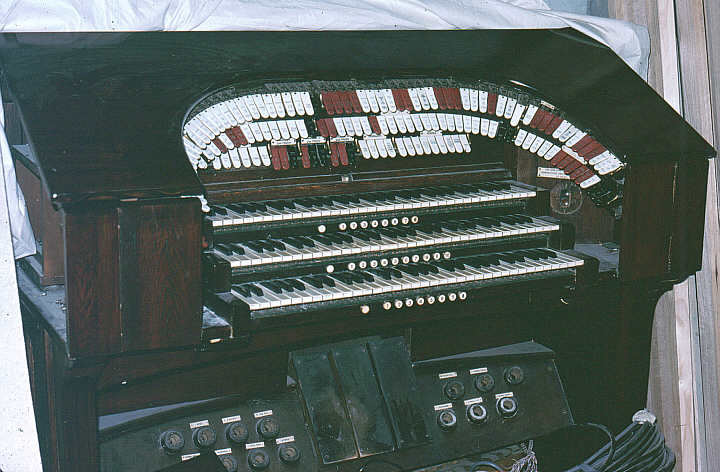
Back to Main Encylopaedia Contents
Dallas Brooks Hall, Grand United Lodge of Freemasons, East Melbourne
Please note: The photographs on this page were taken by me in 1975, before George Stephens commenced work on the instrument, and indicate the state of the organ as he found it

"The Grand United Lodge of Freemasons has completed purchase details for the 3/26 theatre pipe organ owned by former English theatre organist, Arthur Esgate, of Sydney. Arthur Esgate, a naval design engineer, has been gradually building up the organ, which has a three-manual Compton console with various makes of pipework, for many years, and for health reasons decided to sell it.
The Freemasons, who had been looking out for a theatre-style instrument for several years, and who missed out on both the State 4/21 and Regent 4/19 Wurlitzers, and were unable to purchase a couple of others for various reasons, finally said yes, and the first of the Esgate organ has arrived in Melbourne and is being stored prior to installation in the magnificent auditorium." [Vox, January/February, 1973, p. 6]
The Freemasons' purchase of the theatre organ was the subject of an inappropriate and gratuitously critical article from one segment of the classical organ world:
"THEATRE ORGAN A BIG MISTAKE - With the above heading, the Melbourne 'Herald' music critic, John Sinclair, launched into a bitter attack on the suitability of a theatre organ for the Dallas Brooks Hall. Mr Sinclair regarded it as a 'great musical tragedy' that a theatre organ might be purchased by the Grand United Lodge of Freemasons for their superb concert hall.
He admits that an organ of the type he would consider suitable would cost between $50,000 and $100,000, but he doesn't venture to say where that sort of money might come from. But after all, it is the Freemasons' money and it is their decision to buy what is going to be of the most use.
Mr Sinclair is well out of his depth when he states that ...'A theatre organ will, no doubt, attract audiences which at present attend recitals in the Dendy Theatre and elsewhere' - (no doubt he is referring to Moorabbin Town Hall, etc). 'It will certainly not attract the even larger audiences that would want to hear famous organists like Lionel Rogg, E Power Biggs and Marie-Clair Alain perform, say, the immensely popular organ concertos of Handel'.
Does Mr Sinclair really think such recitals would better theatre organ concert attendances of over 10,000? One only has to attend any classical concert to see what audiences they draw and how often. Of course, there are many people who enjoy classical organ recitals, but by far the greater proportion of people enjoy and understand the music played at theatre organ-type concerts. Melbourne Town Hall has found this out, and is promoting a greater number of these this year."
[Arnold, Julien, Vox, January/February, 1973, p. 4]
The composition of the organ purchased from Arthur Esgate will described in detail in its appropriate place when I add the New South Wales web pages to this site. Suffice it to say that it comprised twenty-six ranks of pipes, by Aeolian Skinner, Wurlitzer, Christie, Hill, Norman & Beard, Gottfried, Gray & Davison and Compton, controlled from a Compton console which was formerly the stage console (there were two consoles in that theatre) at the Astoria Theatre, Brixton, London. [Esgate, Arthur, "The Dallas Brooks Hall Theatre Organ", Vox, March, 1973, p. 8]
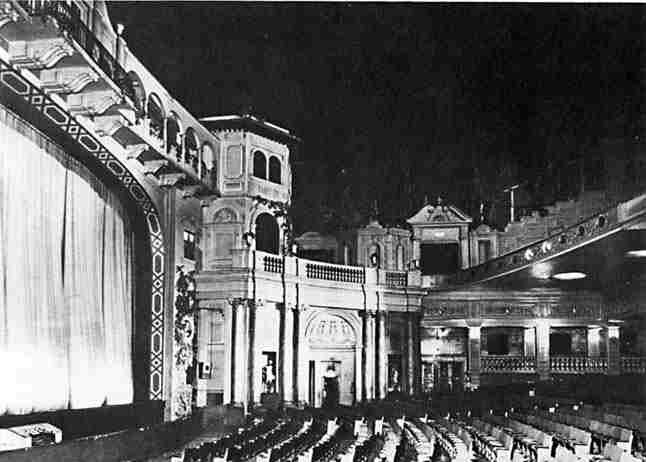
Brixton Astoria - the console seen is the pit console: it was the stage console that is now at Dallas Brooks Hall
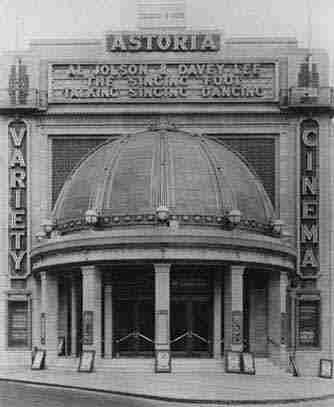
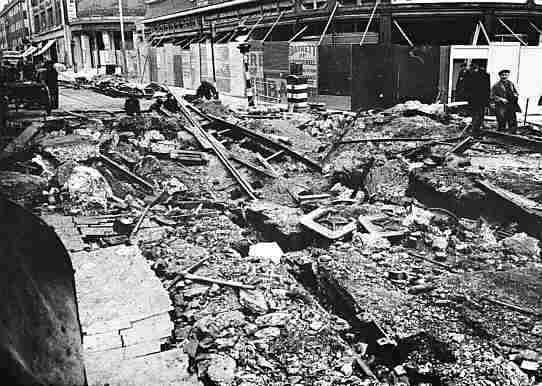
Brixton Astoria was very nearly destroyed in World War 2 - The distinctive entrance dome can be seen in the background of this photograph taken on 22 May, 1941, of the crater caused by a bomb that just missed the theatre
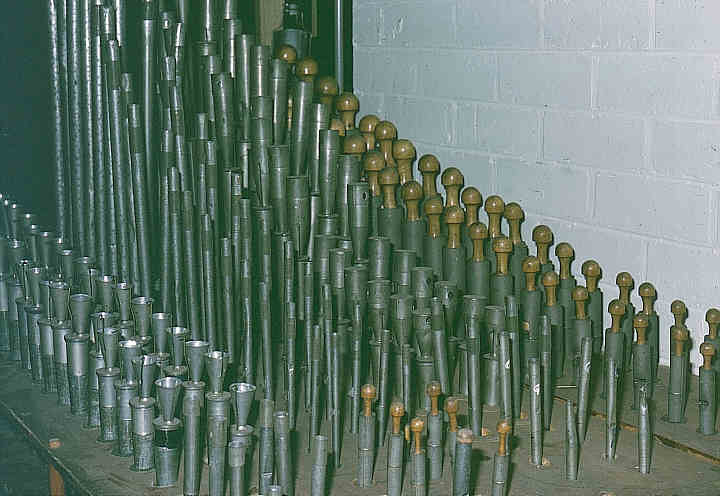
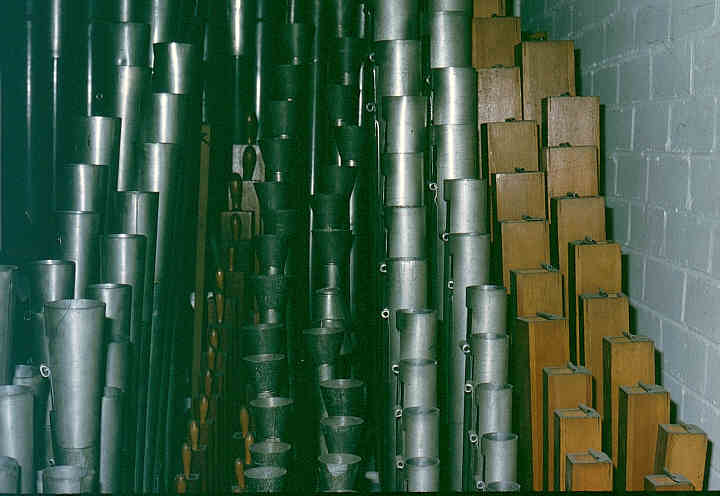
Arthur Esgate himself undertook the job of installing the organ at the hall. In April, 1974, he wrote a detailed progress report, which is here quoted more or less in full:
"As it is now almost a year since the Dallas Brooks Hall purchased the 3/26 from my home - the subject of an article I wrote for March 1973 'Vox' - I felt that readers may be interested in progress that has been made over that time.
To begin with, the chambers at the Dallas Brooks Hall are of extremely good height, something like 18ft., and thus it was decided that all pipework other than Tubas and Trumpets, which had been mitred when installed in my home, should be straightened. Since there was a fair amount of it, this, together with the preparation of the chambers, took some time initially, also a frame-work outside the chambers, but behind the existing organ pipe front was erected to take piano, xylo, glock and chimes together with other items considered best unenclosed.
The relay room is directly under the chambers, and the relays and switches are all in place, with the exception of one Wurlitzer switch stack which badly needs releathering, and which is in the capable hands of Julien Arnold. The blower is installed - this being the unit from the Regent Theatre, Sydney - and the console casework is being re-finished...
The main chamber was tackled first , and things fitted in better than could have been expected. Reservoirs and wind lines in that chamber are almost complete, and since there was all new col-our-coded wiring left connected to the chests, the final wiring to the switch stack spreader will present no problem. The solo chamber is well under way, but I freely admit we could have used about another four feet in width to have made the perfect installation. Most of the chests and the pipework are installed, and windlines being run...
It may be recalled that the organ has three Open Diapasons, two Tibias and four stopped flutes. One diapason has been provided to both the main and solo chambers, but to meet the requirements of the Freemasons, the third one will be unen-closed. With the two Tibias, I hope to be able to site one in each chamber, but for reasons of maintaining maximum accessibility, it may be necessary to put them both in the solo. But, since there is a Chimney Flute, fairly big-scale Stopped Flute and a big-scale Hohl Flute in the main, this should not upset the tonal balance if it is necessary. The Aeolian-Skinner Orchestral Trumpet is very fiery, and if I do the voicing of the organ, I will probably make it even more so. The Kinura is of big scale, and the Wurlitzer Tuba is a Harmonic Tuba with great power.
We come now to the existing organ pipe front. Most of this pipework comprises speaking pipes, and it is intended to utilise these in the tonal scheme, which, if all works out as planned, should give the organ a very healthy 16ft. end. In addition to this, a set of trumpets en chamade will be noticed on the right-hand side of the organ front. These are actually speaking pipes, but only on 2½" pressure, but since I have handed over to the hall my entire stock of spare reed tongues, the tonal plan included fitting these with high pressure reeds, leaving them unenclosed and en chamade, the final result of which should be more than interesting..." [Esgate, Arthur, "Progress at Dallas Brooks Hall", Vox, April, 1974, p.p. 4-5]
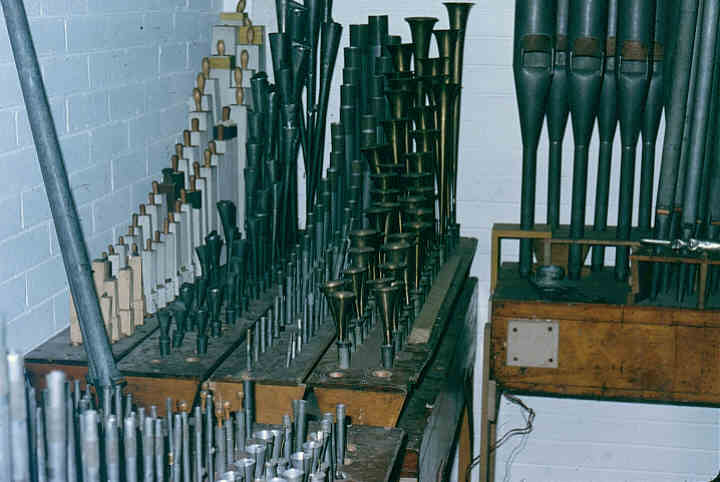
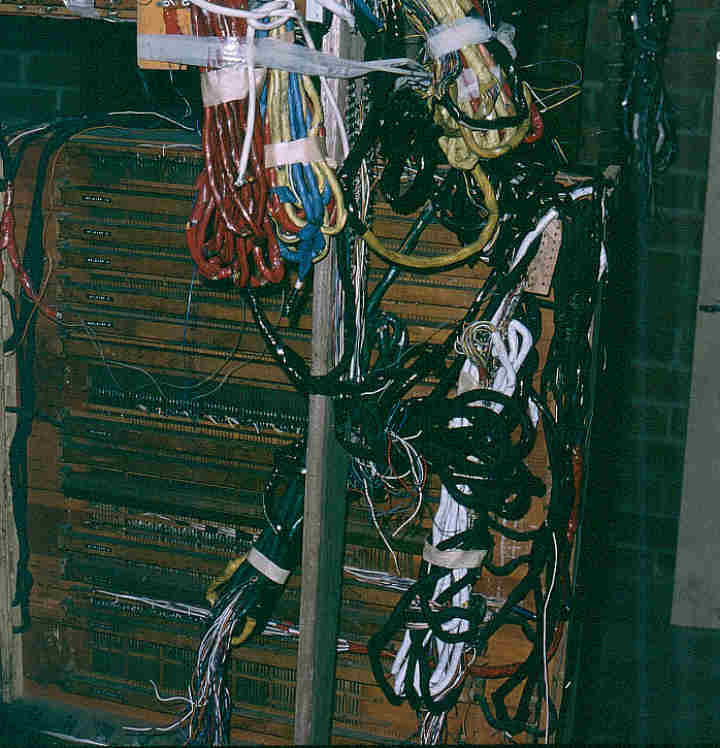
Arthur Esgate's health unfortunately declined, and he was unable to continue with the installation. Sadly, he died on 25 March, 1976, [Vox, April, 1976, p. 9]and was not able hear the organ at Dallas Brooks Hall. Organ builder George Stephens took over the task of installing the organ in 1975, and was faced with a daunting task. For all of Arthur Esgate's enthusiasm and optimism, the organ as it stood in 1975 was a nightmare. I was in Melbourne at the time George took on the job, and stood in the chambers with him, surveying the motley collection of assorted pipework, with birds' nests of wires trailing everywhere, wondering how it could be made into a concert instrument. Many of the ranks of pipes were unsuitable, or incomplete, or both. Although it might have been successful as a residence organ in the hands of its builder, in a concert hall it represented eclecticism of the worst sort. It was quite frankly a mess of ill-matched pipes and an action system best not described.
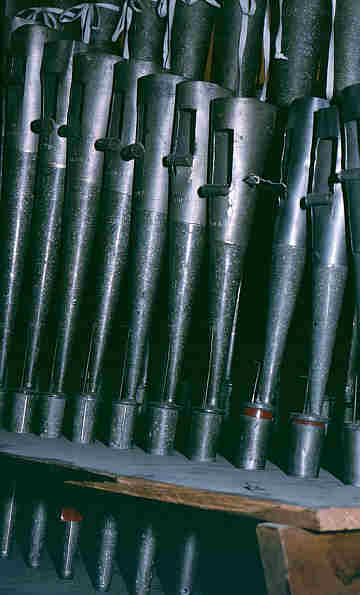
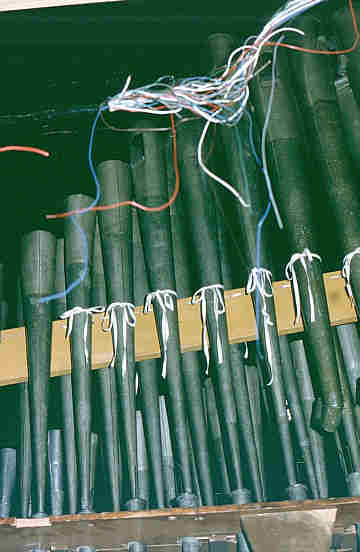
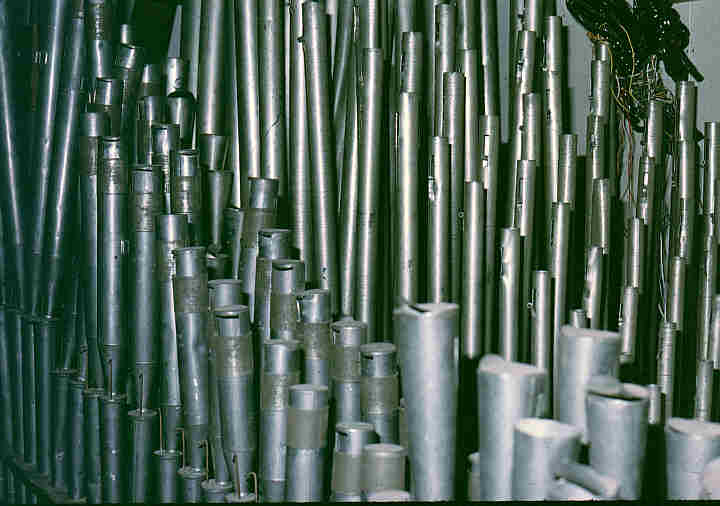
It was clear that drastic redesign of the instrument was necessary. Organists John Atwell, David Cross and Tony Fenelon drew up a specification which took the best nineteen ranks from it, plus the en chamade Trompette, aimed at achieving a theatre organ which could be used to a certain extent as a classical organ:
Orchestral Trumpet - Aeolian
Tuba - Wurlitzer ????
Diapason - Hill, Norman & Beard
Diapason - Aeolian
Tibia - Compton
Tibia - Aeolian/Christie
Clarinet - Christie
Clarinet (free-reed) - Aeolian
Kinura - New
Viol d'Orchestre - Christie
Viol Céleste - Christie
Orchestral Oboe - Aeolian
Strings (2 ranks) - Aeolian
Salicional - Aeolian
Open Flute- Aeolian
Stopped Flute- Aeolian
Vox Humana - Christie
Vox Humana - Aeolian
Trompette en chamade [Atwell, John, "Melbourne's Newest Theatre Organ - The Dallas Brooks Hall Organ", Vox, August, 1978, p. 6]
Mechanical relay switches were dispensed with, an electronic switching system taking their place. The huge Pitman chests, on which much of the pipework stood, were completely reconstructed.
Completion of the organ was divided into two stages. The first stage, which provided an instrument of three manuals and thirteen ranks of pipes, was completed in 1978. [Vox, June, 1978, p. 4]
John Atwell reviewed the organ at this stage:
"One afternoon after work I greeted George [Stephens] and his brother John at the console, along with a few other interested parties, sat down and started to re-familiarise myself with the stoplist I had helped to formulate almost two years previously. The problem was where to start? Perhaps, rather uncharacteristically for a theatre organ, I started with the two diapasons. Both had good tone, which soared out into the auditorium unimpeded by anything except a few pipes in the case-work. They were both different enough from each other to warrant them both being there. What the heck, what about full (half) organ? Gradually adding stops that were playing, I built up to full organ. Even at this stage, it was a thrilling sound. Then went down the small Tibia and on with the tremulants, and, hey presto, one hell of a lush theatre sound, even without the big Tibia, and of course the big reeds. The present line-up of ranks is as follows: the two diapasons, the small tibia, the two clarinets, all the strings and flutes and the Christie Vox Humana. I turned to George and commented that if this is any indication of what was yet to come, I could hardly wait for the second stage. Turning to each rank individually, there was not one which did not earn its place in the line-up. Even the Salicional, the softest stop on the organ, which at present is hardly heard because of blower noise, will have its rôle to play. The two flutes have quite different colourations and both will be most useful. The diapasons are of a good scale to balance with the rest of the organ. The Aeolian clarinet is an interesting set of pipes. The tone is generated by a freely vibrating reed, not unlike a harmonium reed, placed across the windway in the resonator. Normal reeds have a reed tongue vibrating against a hollow piece of metal called a shallot. The tone of the free-reed clarinet is much smoother than the solo clarinet and will be most suitable for an accompaniment tone colour.
The pipework is in concrete chambers behind the display pipes, and thanks to the new thick swell shutters, the difference in volume between closed and open swell is quite incredible. The pipework on show is all real, but only the trumpet will be connected up. The percussions are unenclosed, and to say that you can hear them is an understatement. They are on the list for softening down!
Even with the limited amount of voicing and regulation that has been done, the organ ensemble blends extremely well. The tremulants have yet to be properly set. On casual inspection in the pipe chambers, the quality of the work-manship which had gone into the restoration of the organ was obvious. Pipework once beaten and broken was sitting row after row as if they had recently come from the pipe shop. But a lot of the work was inside the big converted Pitman chests, away from view. In the room below, instead of a conglomeration of switch stacks of a variety of makes, there were about five printed circuit boards roughly 4ft x 3ft, one behind the other, mounted on the wall - so neat and tidy - and so reliable...
Although the organ is being used for Grand Lodge cere-monies, it is not getting a public airing at present, mainly because of the blower noise. This will be rectified in stage 2, probably with the provision of a new blower. Submissions for stage 2 have already been made, and with a bit of luck, the instrument could possibly be complete by Easter of next year." [Atwell, John, "Melbourne's Newest Theatre Organ", Vox, August, 1978, pp. 7-8]
Hopes of an early completion of the instrument proved in vain, for, as John Atwell wrote to me at Christmas, 1978:
"The only problem is that [George Stephens] has made such a good job of the first stage that they don't intend to proceed at present with the second stage - the part with all the nice reeds, big tibia, etc." [Atwell, John, letter, 15 December, 1978]
The organ, although still incomplete, was heard at the TOSA 1979 Easter Convention, when it was played by John Atwell and David Johnston. Adelaide visitor Baden Pike commented:
"Although the organ does not have any major reeds going at this stage, it nonetheless has a big, ambient, in-theatre sound, and due to the nature of its many-manufactured pipework sounds quite different from any other organ that we know of in Australia." [Pike, Baden, Convention Review, SA TOSA News, TOSA (SA), Adelaide, May, 1979, p. 9]
Unfortunately, the organ has never been completed. Rumours have recently been prevalent that the future of Dallas Brooks Hall isuncertain; however, no concrete news has yet been forthcoming (2001). I shall update this page as and when more news arrives.
Back to Main Encylopaedia Contents